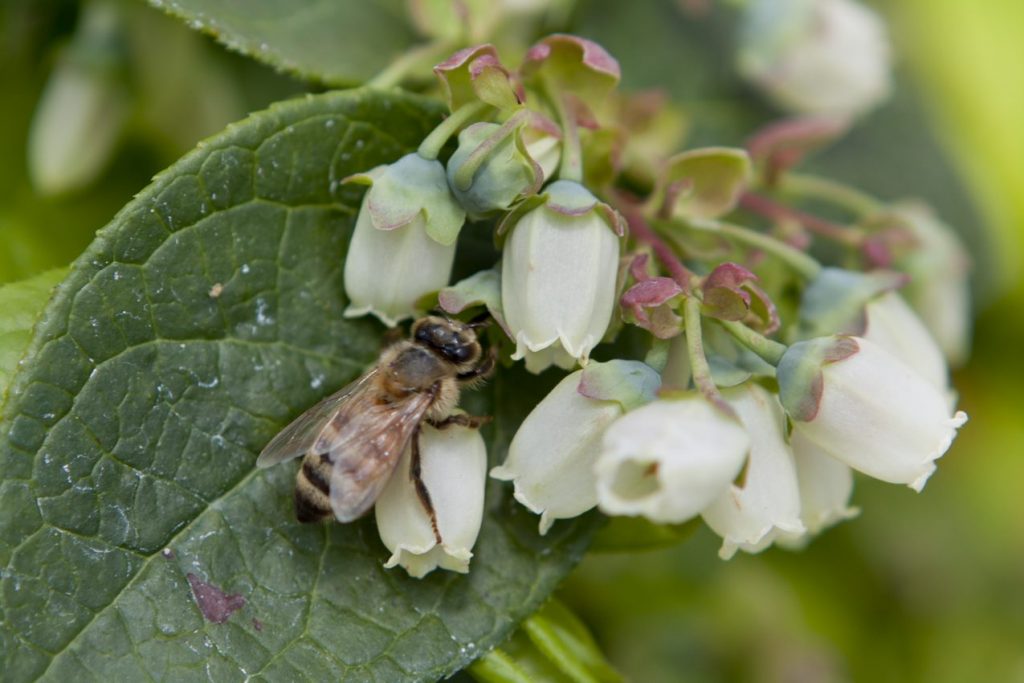
December 10, 2020
By: Samantha Murray, grenrosa@ufl.edu, 949-735-1076
GAINESVILLE, Fla. — Chew on this the next time you eat a blueberry: Every single blueberry is the result of a flower that was pollinated by a bee.
In other words: no buzz, no berry.
With that in mind, it’s no wonder blueberry growers bring in hives of honey bees or bumble bees when their blueberry bushes are in flower.
“We are big believers in pollination on blueberries. We believe pollination helps increase berry size and weight and increases the overall crop yield,” said Ryan Atwood, co-owner of H&A farms, which owns, leases and manages more than 350 acres of blueberries in north and central Florida.
But pollinating blueberries with bees isn’t an exact science — yet.
Successful pollination depends on a variety of factors, such as when beehives are introduced or how much buzz a blueberry flower needs to release its pollen.
Moreover, blueberry growers across the United States report that ineffective pollination is a top concern for their business, as it directly affects the amount and quality of product they can bring to market, said Rachel Mallinger, an assistant professor in the UF/IFAS entomology and nematology department who specializes in pollinators.
This is why Mallinger and several other researchers from blueberry-growing states have teamed up to develop recommendations and tools to help growers optimize pollination.
In addition to Mallinger, the research team includes scientists from Michigan State University, Oregon State University and Washington State University. Rufus Issacs, a professor in the department of entomology at Michigan State University, will lead the project, which is funded by a $2 million grant from the National Institute of Food and Agriculture, part of the U.S. Department of Agriculture.
“Some years blueberry pollination goes well, other years not so much, so we are looking to help growers take some of the guesswork out of it,” Mallinger said. “Our ultimate goal is to provide a tool we’re calling the pollination planner. The pollination planner will help growers decide how many bees to use and when to bring them in based on their location, climate, size of their farm, and varieties of blueberry they grow.”
Mallinger and her research team will partner with Florida blueberry growers, including Atwood, to run their field experiments. The Florida blueberry industry is a $60 million-a-year business, and this research on pollination will help support this growing commodity.
“This research will help us understand the economic benefits of honey bees for pollination and what number of hives are needed to properly pollinate,” Atwood said.
The multi-state project has several components, Mallinger said.
“Our contribution in Florida will be to look at our modern southern highbush blueberry varieties and determine their pollination needs and what makes them attractive to bees. Some varieties need to be pollinated with pollen from a different blueberry variety to achieve optimal yields, while others are more self-compatible. Some varieties may hold on to their pollen tightly, others less so. Even the color or size of the flower, or how much nectar it produces, might impact how attractive that flower is to a bee,” she said.
Identifying those traits is just the first step, Mallinger added.
“Blueberry breeders are usually trying to develop varieties that have good taste, resistance to pests, things like that. But we don’t think about how likely a blueberry variety is to be pollinated. If we can identify those traits that lead to more pollination, we can inform breeding efforts,” she said.
Other researchers on the project will develop recommendations for the number of bees — called stocking density — needed to pollinate modern varieties of blueberry. Another component of the project will investigate how weather conditions, such as extreme heat, influences pollination success.









